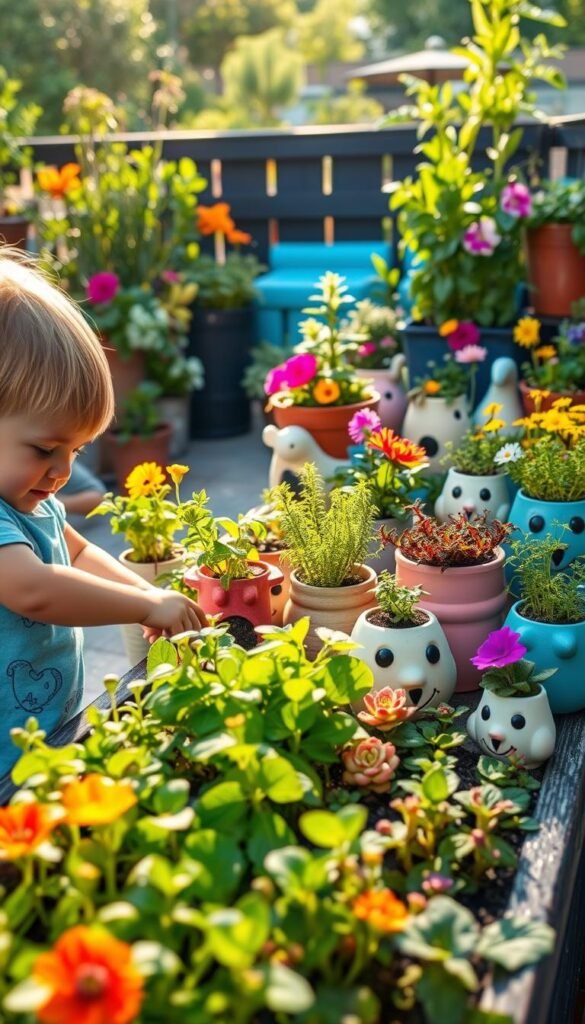Want to spark excitement about nature and nutrition in your family? Container gardening offers the perfect blend of creativity and simplicity for busy households. Whether you’re working with a sunny windowsill or patio space, these compact growing projects adapt to any lifestyle while teaching valuable lessons about responsibility and plant lifecycles.
Studies show 76% of families who garden together report improved eating habits. When young growers select their preferred varieties – from pizza-themed herbs to rainbow-colored veggies – they develop deeper connections with their food. This hands-on approach transforms mealtime into a celebration of their efforts, as detailed in our guide to building healthy eating habits through homegrown.
Quick-growing options like snap peas (ready in 60 days!) keep enthusiasm high, while recycled containers make startup costs minimal. Every sprout becomes a victory, encouraging children to take pride in nurturing living things. You’ll love watching their confidence bloom alongside basil plants and cherry tomatoes.
This shared activity creates lasting memories while teaching environmental stewardship. Through simple daily observations and care routines, families bond over the magic of watching seeds transform into snacks. Ready to dig into a hobby that grows with your family?
Essentials for Kids’ Gardening Success
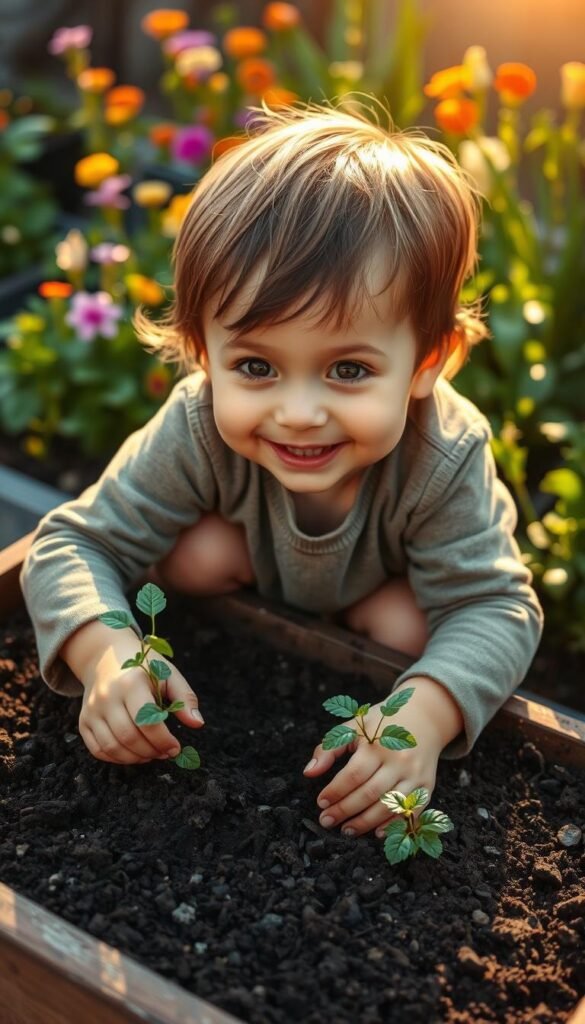
Successful gardening with little ones requires matching their curiosity with the right tools. Young minds thrive when interactive elements meet edible rewards – imagine their delight when plucking sweet cherry tomatoes or rubbing fragrant mint leaves between their fingers.
Understanding Child Engagement in Gardening
Children naturally gravitate toward plants offering instant feedback. Quick-growing options like radishes (ready in 25 days!) pair perfectly with slower-growing strawberries. This combo teaches patience while delivering mini victories that fuel ongoing interest.
Three sensory superstars keep hands busy and minds curious:
- Crunchy sugar snap peas for taste adventures
- Velvety lamb’s ear leaves for tactile exploration
- Bright nasturtium flowers for visual pop
Tips for Safe and Fun Gardening Practices
Start with lightweight tools sized for small grips. Teach kids to identify safe-to-eat plants and wash produce before sampling. A simple routine works best: 10 minutes daily for watering checks and progress chats.
Turn safety lessons into games – who can spot the ripest pepper? Celebrate messy moments as learning opportunities. When a seedling gets overwatered, turn it into a science lesson about root health.
Selecting the Perfect Container and Space
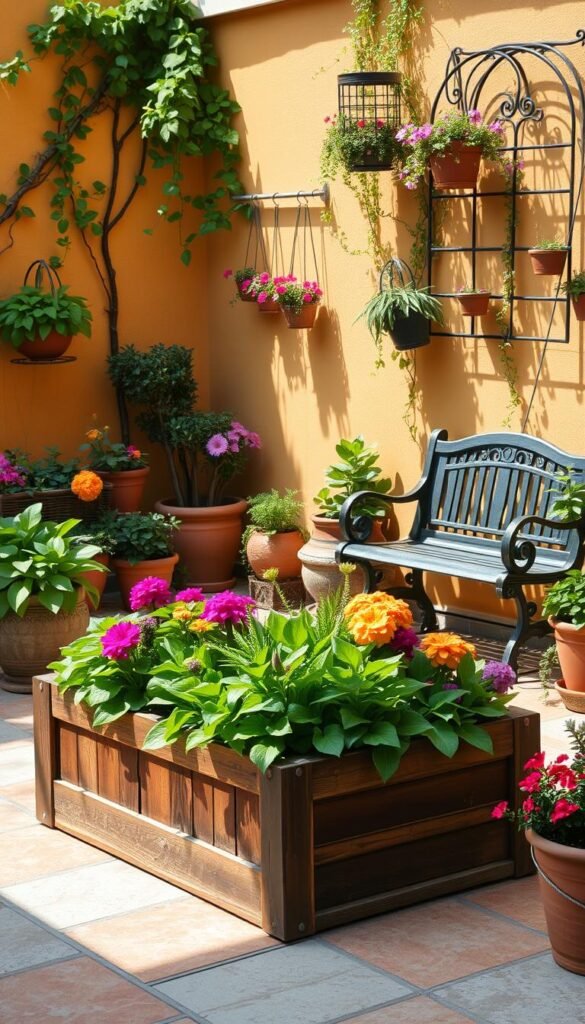
Finding the right spot and vessel makes all the difference in growing thriving plants. Start by picking areas you naturally visit daily – near a kitchen window or along your porch walkway. These high-traffic spaces keep your garden visible and care routines consistent.
Choosing Sun-Filled Locations
Most edible plants need 4-6 hours of sunlight to flourish. Observe how light moves across your patio or balcony throughout the day. South-facing spots often work best, but don’t worry if you only get partial sun – leafy greens and herbs adapt well.
Three smart placement strategies:
- Use wheeled planters to chase sunlight patterns
- Elevate pots on stands near reflective walls
- Rotate containers weekly for even growth
Evaluating Containers for Every Budget
Your plant’s home can be as simple as a drilled plastic bin or as elaborate as a self-watering planter. The key? Drainage. Add pebbles to pots without holes, or try lining baskets with coconut coir.
Budget-friendly ideas that spark creativity:
- Upcycle old colanders into strawberry planters
- Stack cinder blocks for vertical herb walls
- Convert ladder shelves into tiered gardens
For families new to container gardening basics, start with 2-3 medium-sized pots. This manageable approach lets you experiment with different materials while learning your plants’ needs.
Planting Basics: Soil, Watering, and Sunlight

The foundation of every thriving potted plant begins below the surface. Quality soil and smart watering habits create the perfect environment for roots to spread and leaves to flourish. Unlike traditional gardens, container growing requires extra attention to moisture levels and nutrient balance.
Optimal Soil Mix and Watering Techniques
Skip the backyard dirt – container plants need lightweight potting mix that breathes. Look for blends with perlite or vermiculite to prevent soggy roots. Fill your pots two-thirds full initially, leaving space to top up as plants grow.
Test soil moisture daily using the finger method: if the top inch feels dry, it’s time to water. Pro tip: Morning watering reduces evaporation and gives plants time to drink before afternoon heat. During heatwaves, check pots twice – terra cotta dries faster than plastic.
Boost your potting mix naturally:
- Mix used coffee grounds for nitrogen
- Crush eggshells for calcium
- Add banana peels for potassium
Remember – consistency beats strict schedules. A wilted plant might need water, but yellow leaves often signal overwatering. Teach young helpers to observe these clues while caring for their green friends.
Kids’ Container Gardens: Let Them Pick Their Own Seeds
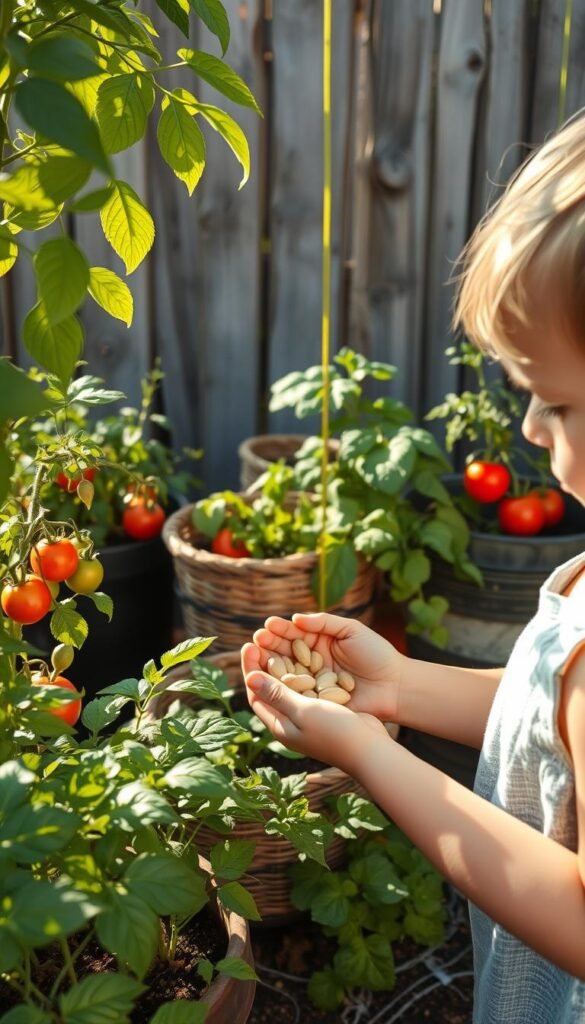
Transform everyday snacks into garden starters with this hands-on seed-saving adventure. Watching food scraps become next season’s plants creates powerful “aha” moments for young minds. Seed harvesting turns lunchbox leftovers into living science projects, blending practical skills with delicious rewards.
Step-by-Step Seed Selection Guide
Begin with peppers – their seeds separate cleanly from flesh. Show children how to shake dried pods over plates. For pulpy varieties like tomatoes, make rinsing a game: “Who can find five shiny seeds first?”
| Plant | Ease of Harvest | Drying Days | Special Tips |
|---|---|---|---|
| Bell Peppers | Easy | 3-4 | Shake dried pods |
| Tomatoes | Moderate | 5-6 | Ferment 2 days first |
| Cucumbers | Simple | 4-5 | Dry on paper towels |
| Cantaloupe | Easy | 5-7 | Rinse thoroughly |
Engaging Activities for Harvesting Seeds
Magnify fresh and dried seeds side-by-side. Ask: “What changes do you see?” Track daily progress in a journal. Pro tip: Use colored markers to date each drying batch.
Turn old pill bottles into treasure containers. Let kids design labels showing plant names and harvest dates. Store collections in a visible spot to build anticipation for spring planting.
“The act of saving seeds connects us to generations of growers before us.”
Five days of careful drying teaches patience. Nightly seed-shuffling becomes a calming ritual. When stored properly, these tiny time capsules await their moment to sprout new life.
Creative Plant Choices to Engage Young Gardeners
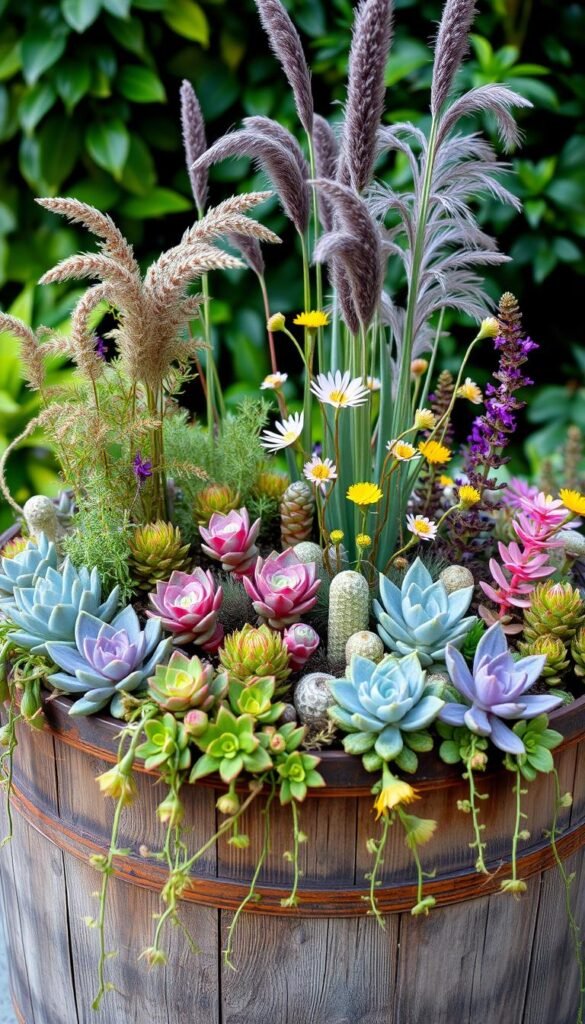
Growing spaces become wonderlands when filled with plants that delight the senses and spark imagination. Select varieties offering surprises at every stage – from oversized seeds to vibrant colors – to maintain excitement through the growing season.
Fun Crops That Spark Curiosity
Pumpkins win hearts with seeds bigger than a nickel, perfect for little fingers to plant. Mini varieties like Boo and Jack-Be-Littles thrive in pots, transforming balconies into pumpkin patches. Pair these with radishes – nature’s magic trick – pushing up leafy tops in just three days.
Cherry tomatoes become living candy machines. Sweet varieties like Sungold and Black Cherry offer rainbow hues for snacking straight from the vine. Mix colors in one pot for a fruity surprise basket.
Exploring Edible Flowers, Gourds, and More
Sunflowers tower over other plants, creating living forts with snack-packed faces. Their seeds attract chirping visitors, turning gardening into wildlife theater. Edible flowers like nasturtiums and pansies add confetti colors to salads while teaching about pollinator friendships.
Gourds keep the fun going post-harvest. Dry Birdhouse varieties for craft projects or paint speckled Goblin Eggs. These quirky crops show how gardens feed both bodies and creativity.
| Plant Type | Engagement Factor | Growth Time |
|---|---|---|
| Mini Pumpkins | Large seeds, familiar shapes | 90-100 days |
| Rainbow Radishes | Quick sprouting | 25-30 days |
| Cherry Tomatoes | Instant snacks | 55-70 days |
| Sunflowers | Bird attraction | 70-90 days |
For families ready to explore more hands-on projects, our guide to easy seed starting offers playful ways to begin. Remember – the best plants are those that make young growers gasp, giggle, and ask “Can we grow more?”
Interactive Activities and Tips for Gardening with Kids
Transform everyday recyclables into vibrant garden projects that blend creativity with nature education. These hands-on approaches turn routine tasks into memorable learning moments while reducing household waste.
DIY Container Decoration Ideas
Empty yogurt cups and egg cartons become blank canvases for artistic expression. Let young gardeners personalize pots using washable paints or weatherproof stickers. Pro tip: Use permanent markers on plastic milk jugs to create translucent designs that glow in sunlight.
Three ways to enhance motor skills:
- Practice grip strength by squeezing glue bottles
- Develop precision through seed spacing exercises
- Build color recognition with patterned sticker arrangements
Seed Experiment Fun and Learning
Turn leftover toilet paper rolls into protective collars for seedlings. This simple activity teaches plant anatomy while repurposing household items. Track growth rates in decorated cups versus plain pots for mini science experiments comparing root development.
Create a germination journal:
- Sketch daily changes in seed structure
- Measure sprout height with ruler strips
- Record watering amounts in color-coded charts
Using Recyclables for Creative Planting
Old cereal boxes become instant plant markers when cut into strips. Encourage children to invent silly names for their crops while practicing letter shapes. Did you know? Transparent salad containers make perfect mini-greenhouses for observing condensation cycles.
Establish a daily check-in routine:
- Morning moisture tests using finger probes
- Afternoon sunlight tracking with shadow drawings
- Evening growth celebrations with clapping games
These engaging methods transform plastic waste into gardening gold while fostering responsibility. Watch confidence bloom as young growers tend their upcycled masterpieces!
Troubleshooting and Seasonal
Every garden faces challenges, but they’re opportunities to grow smarter. If seedlings stretch tall and thin, they’re begging for more light – move pots to brighter spots or add reflective surfaces. Brown leaf edges? Check soil moisture before watering again. Consistency matters most, especially when balancing sun exposure and hydration.
Seasonal shifts change the game. Rotate crops every few months – swap summer tomatoes for cool-weather kale. When frost threatens, bring tender herbs indoors near sunny windows. Our guide to starting seeds indoors helps extend growing seasons with simple setups.
Celebrate successes and learn from setbacks. That leggy basil plant? Turn it into pesto while discussing root health. Forgotten radish sprouts? Compost them and try again. Nature’s rhythm teaches resilience – each season brings fresh chances to nurture life and curiosity.

